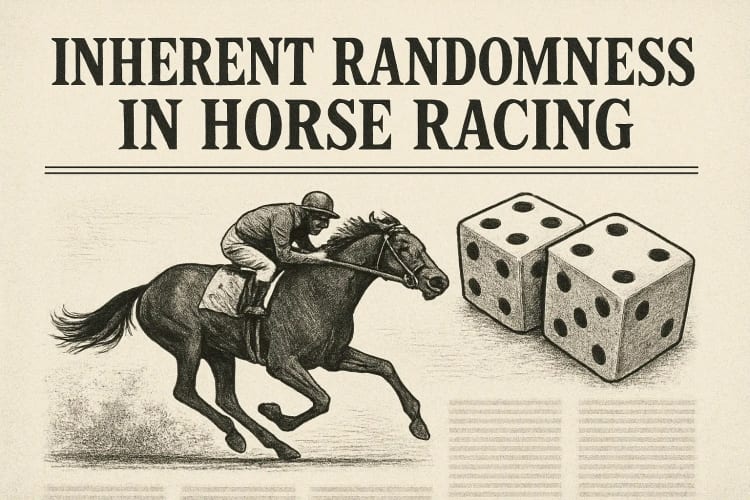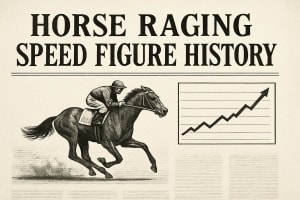
AI versus Chaos: Navigating Horse Racing's Inherent Unpredictability
An honest examination of what AI can and cannot achieve in horse racing prediction. While marketing claims promise 93% accuracy, the reality shows more modest 32-43% win rates. Discover why transparency and education matter more than impossible promises in the GB/Ireland racing market.
AI versus Chaos: Navigating Horse Racing's Inherent Unpredictability
Modern AI systems are achieving more modest but meaningful improvements in horse racing prediction, with the best commercial systems reaching 32-43% win rates compared to the betting public's typical performance, demonstrating that while the sport's inherent randomness cannot be eliminated, sophisticated data analysis can provide genuine edges. This breakthrough presents a significant opportunity for Sportily's AI-powered platform to bridge the gap between professional syndicates and casual bettors in the GB/Ireland market, where current tools fail to provide transparent, accessible predictions that explain their reasoning. The convergence of machine learning advances, real-time biometric tracking, and market-specific expertise creates an unprecedented opportunity to transform how both professionals and enthusiasts approach this $115 billion global industry.
The Chaos Beneath the Surface
Horse racing's unpredictability stems from a complex web of interacting variables that can overturn the most careful analysis in seconds. Weather alone introduces multiple layers of randomness: temperatures above 70°F cause horses to tire unpredictably as they struggle to dissipate heat, while rain transforms track conditions in ways that favor some horses dramatically over others. Track bias phenomena add another dimension of complexity, with rail positions, surface conditions, and even daily maintenance schedules creating advantages that shift throughout a race day. The sport's biological elements compound this uncertainty - horses experience day-to-day mood variations, minor injuries undetectable until race conditions reveal them, and digestive issues that affect up to 78% of performance horses through equine ulcers.
Human factors multiply these variables exponentially. Jockeys make split-second tactical decisions that can determine outcomes, while equipment failures from loose shoes to saddle slippage introduce mechanical randomness. Field dynamics create their own chaos through pace scenarios, traffic problems, and post position effects that vary by track configuration. Perhaps most dramatically, starting gate incidents can eliminate contenders before races begin, as demonstrated by Quality Road's infamous wrestling match at the 2009 Breeders' Cup Classic or Spanish Moon's gate refusal leading to a six-month ban. Academic research by Ali (1998) analyzing over 15,000 races confirmed that even sophisticated probability models exhibit systematic biases, with no traditional approach constructing consistently profitable betting strategies.
Traditional Handicapping's Noble Struggle
Traditional handicappers have developed sophisticated methodologies to impose order on this chaos, creating frameworks that remain valuable despite their limitations. Andrew Beyer revolutionized the field in 1975 with his speed figures, standardizing performance across different tracks and distances while accounting for daily track variants. These figures, typically ranging from 60-130 for competitive horses, became the foundation for modern handicapping, though they cannot account for pace scenarios, traffic problems, or bias situations. Handicappers layer multiple analytical approaches: class evaluation to assess competition quality, form cycle analysis to identify peak performance periods, and trip handicapping to spot horses disadvantaged by previous race dynamics.
The most successful traditional practitioners combine these quantitative methods with qualitative assessments. Steve Davidowitz's comprehensive approach integrates key race methodology with advanced exotic wagering strategies, while Tom Ainslie established frameworks covering everything from breeding analysis to track skulduggery detection. Trainer and jockey pattern recognition adds another dimension, with handicappers tracking barn-specific patterns, equipment changes, and riding style compatibility. Visual assessment through paddock inspection attempts to gauge readiness through physical appearance and demeanor, though subjective interpretation varies widely between observers. Despite these sophisticated approaches, traditional methods face inherent limitations: systematic biases toward favorites, incomplete information about horse condition, and the mathematical challenge of overcoming track takeout percentages that make long-term profitability extremely difficult.
Machine Learning's Modest Reality Check
Modern AI systems have transformed horse racing prediction by processing vast datasets that would overwhelm human analysis, achieving meaningful improvements over traditional methods despite the sport's inherent unpredictability. Leading commercial systems like EquinEdge achieve 32.9% win rates for their top selections, while experimental no-code AI platforms have demonstrated 43.75% success rates - approximately 10 percentage points better than the betting public. These systems integrate multiple data streams: historical performance metrics including Beyer Speed Figures and class levels, real-time GPS positioning data with survey-grade precision, and sophisticated biometric monitoring that can predict injuries six races before they occur based on stride characteristic changes.
The technical sophistication extends far beyond simple statistical analysis. Commercial systems like StrideMASTER and OneSix Solutions deploy multi-camera arrays and ultra-wideband tracking across 3,000-4,000 unique horses per track, while smartphone-based systems like Sleip AI achieve 2mm precision in markerless motion analysis. However, academic research reveals the true challenges: NYC Data Science Academy found that "neither of the models produced promising distributions based on implied odds" despite sophisticated logistic regression and random forest approaches. One experienced data scientist spent three years building models, noting that "unfortunately, the model never turned a profit... I couldn't help but feel a sense of failure, having invested so many hours."
These systems handle uncertainty through sophisticated probabilistic modeling, implementing Kelly Criterion for optimal bet sizing and Bayesian hierarchical models for thoroughbred performance analysis. Real-world implementations show mixed results: while some experimental platforms have achieved short-term profits (140% ROI over small samples), long-term sustainable profitability remains challenging due to the 15-20% track takeout that creates a significant hurdle rate. The reality, as one expert noted, is that "horse racing gambling is basically the suckers against the quants," where sophisticated betting syndicates with volume rebates maintain structural advantages over casual bettors, while many commercial AI services make inflated claims that independent reviews expose as ineffective or potentially fraudulent.
Current Industry Battles and Gaps
Despite technological advances, the horse racing prediction industry faces significant challenges that create opportunities for innovative platforms. Data accessibility remains fragmented across multiple disconnected databases - Equibase, Timeform, Racing Post, and Daily Racing Form - each with different formats and access requirements. Professional dominance creates a "quants versus suckers" dynamic where betting syndicates with up to 300 employees and proprietary algorithms crowd out casual users who face prohibitive costs for quality handicapping software. The black box problem plagues existing AI tools like EquinEdge and RacingOracle, which provide predictions without explaining their reasoning, undermining user trust and limiting educational value.
Critical gaps persist in course-specific analysis for GB/Ireland tracks, with limited availability of detailed bias patterns and distance preferences despite these factors' proven importance. No single platform effectively combines form data, genetic information, trainer patterns, jockey statistics, and real-time race data into a unified, accessible interface. Mobile optimization remains poor across most platforms, problematic when 5-6 second delays in live data can impact trackside betting decisions. The regulatory landscape adds complexity, with Ireland's new Gambling Regulation Bill introducing advertising watersheds and compliance requirements through the Gambling Regulatory Authority of Ireland, while the UK maintains its established framework through the Gambling Commission with recent AI integration guidelines.
The Fundamental Data Structure Problem
Academic research reveals why even sophisticated AI struggles with horse racing prediction. As one researcher noted, horse racing data is "fundamentally complicated and unstructured. It's more like graph instead of table." Unlike image recognition or language processing, where data has consistent structure, horse racing presents unique challenges:
- Variable field sizes (10-16 horses per race) make consistent modeling difficult
- Limited training data: even successful horses only run ~60 times in their careers
- Complex interdependencies between horses, jockeys, trainers, and conditions
- Non-linear relationships that change based on track, weather, and competition
A data scientist who attempted deep learning approaches found the results "completely fiasco," achieving only ~68% accuracy for picking between two horses. Another researcher noted that "the accuracy of the final prediction also needs a large amount of data to verify" - data that simply doesn't exist in sufficient quantities for reliable machine learning.
Sportily's Path to Transformation
Sportily's AI-powered platform is uniquely positioned to address these challenges by combining cutting-edge technology with transparent, accessible design specifically tailored for the GB/Ireland market. Rather than promising impossible accuracy rates, the platform can bridge the professional-casual divide through interpretable AI that explains its reasoning, transforming black-box predictions into educational opportunities. By implementing tiered offerings - a free tier with basic predictions and explanations, intermediate features with customizable factors, and professional tools with API access - Sportily can serve the entire market spectrum while maintaining sustainable revenue through a freemium model proven successful in similar markets.
For course-specific analysis, Sportily can leverage its focus on GB/Ireland racing to build the definitive database of track bias patterns, going preferences, and distance-specific modeling that current platforms lack. Real-time integration becomes a competitive advantage through mobile-first development optimized for trackside decisions, incorporating live odds comparisons, market movement alerts, and push notifications for scratches or condition changes. The platform can differentiate through educational components that demystify AI predictions, creating learning modules that transform casual punters into informed bettors while fostering community engagement through forums and tip-sharing with performance tracking.
Strategic partnerships amplify these advantages: direct API connections with Betfair and major UK/Irish bookmakers enable seamless betting integration, while potential collaboration with Total Performance Data could provide exclusive access to live race tracking feeds. By maintaining regulatory compliance from inception and building trust through transparency about realistic expectations, Sportily can establish itself as the trusted authority for AI-powered racing analysis.
The immediate opportunity involves launching a GB/Ireland-specific platform that acknowledges the inherent limitations of horse racing prediction while providing genuine value through better data organization, transparent methodology, and educational content. Rather than competing on impossible accuracy claims, Sportily can succeed by helping users understand both the potential and limitations of data-driven analysis, ultimately positioning itself as the definitive platform that makes sophisticated analysis accessible to all users while maintaining honest expectations about what AI can and cannot achieve in this fundamentally unpredictable sport.
Ready to get started?
Experience transparent AI-powered horse racing analysis with Sportily
Next Steps
Ready to see what realistic AI can do for your horse racing analysis? Start with our free tier to explore GB/Ireland racing insights, or contact our team to learn about professional features.
Related Posts

The AI Revolution in Horse Racing Handicapping
Discover how professional handicappers are combining traditional expertise with AI-powered analytics to gain competitive edges in modern horse racing markets. Learn the proven strategies that separate successful handicappers from the crowd and how platforms like Sportily are revolutionizing race analysis through real-time data, predictive modeling, and course-specific insights.

The Complete Guide to Horse Racing Speed Figures: From Beyer to Timeform
Discover the mathematical secrets that separate winning horse racing professionals from casual gamblers - speed figures have revolutionized racing analysis since the 1970s, but most bettors still don't know how to use them effectively. From Beyer's gold standard to cutting-edge AI systems like Sportily, learn exactly how top handicappers achieve consistent profits and transform racing from random chance into predictable science.